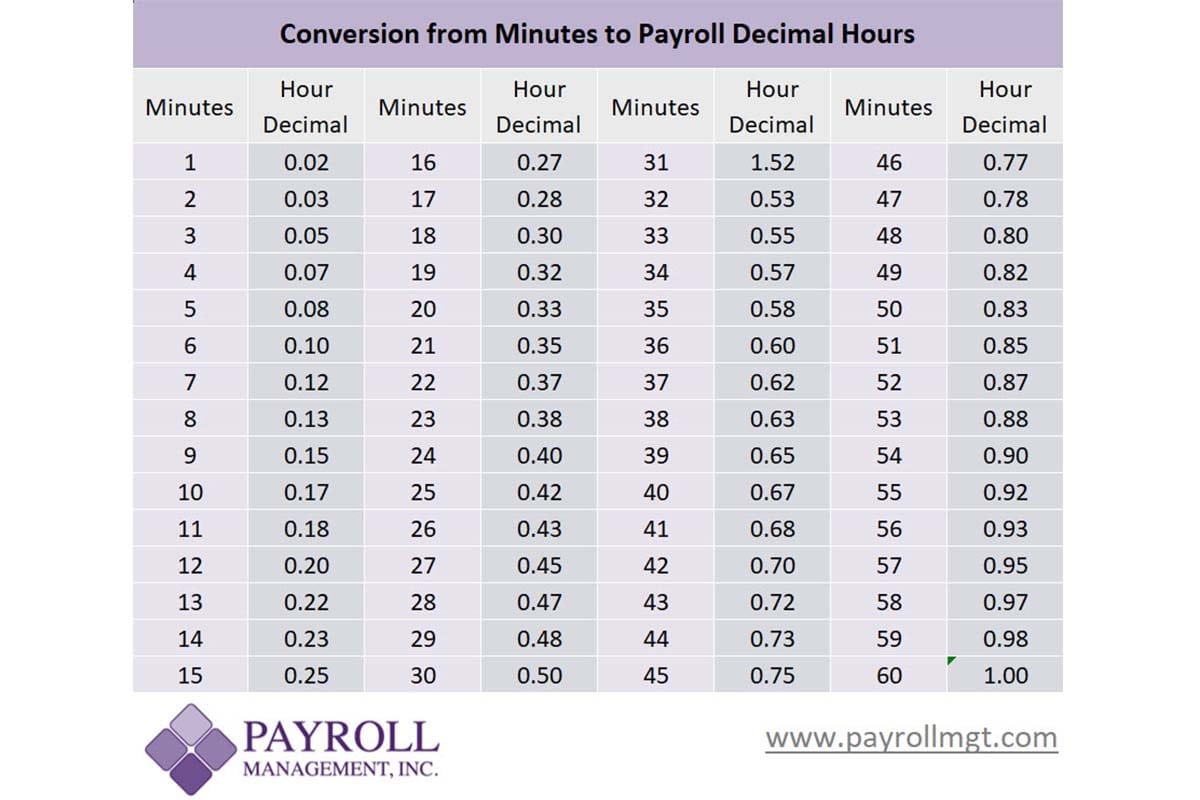

Manually converting employee hours and minutes to decimal values (hundredths) is time-consuming and prone to errors. One minute is equal to 1/60 degrees: 1 (1/60)° 0.01666667° One second is equal to 1/3600 degrees: 1' (1/3600)° 2.77778e-4° 0.000277778° For angle with d integer degrees m minutes and s seconds: d° m s' The decimal degrees dd is equal to: dd d + m/60 + s/3600. Minutes to Decimals Time Conversion Chart To get her net pay, you'll have to factor in deductions and taxes. Melanie’s weekly pay based on her total hours is then: 37.7 hours x $15 = $565.50 This means that 37 hours and 42 minutes convert to 37.7 hours in decimal time. Then you have to add the converted minutes to the hours: 37 + 0.7 = 37.7 The correct calculation is thus: 42 minutes/60 = 0.7 You have to convert minutes into decimals. I'm trying to convert minutes to hours in decimal and round to the nearest fifteen minutes (rounded up ). This is wrong since, once again, an hour is made up of 60 minutes, and not 100. However, if you take 37 hours and 42 minutes as they are, you would get 37.42. Then you need to multiply the number of hours she worked by her hourly rate to determine her weekly total pay. Note that 1 hour is equal to 60 minutes or 3600 seconds. To get the total decimal seconds we use the formula: s (hours 3600) + (minutes 60) + seconds. To get the total decimal minutes we use the formula: m (hours 60) + minutes + (seconds / 60).

The hourly rate that she receives is $15.įirst, you have to take the information from her weekly time card or timesheet that contains her clock-in and clock-out times (ee timecard templates here). To get the total decimal hours we use the formula: h hours + (minutes / 60) + (seconds / 3600). The part where it starts to get tricky is when you get into the odd numbers. So to convert from minutes to decimal representation simply use the formula below: Decimal Hours Minutes / 60. So it would follow that 30 minutes is equivalent to a decimal of 0.5. This week she has worked 37 hours and 42 minutes (and no overtime hours). One Hour 60 minutes which in decimal representation is 1. It is also essential for keeping track of lunch breaks, general break time, overtime pay, and holidays. This is crucial for hourly staff members, who are often non-exempt employees. Note that 24 here represents 24 hours, the number of hours in a day. If you have time value in decimals and you want to convert it into hours, all you have to do is multiply it by 24. Adding them all together we have 7200 seconds + 2700 seconds + 45. Usually, multiplying the original time value by the number of hours, minutes or seconds is the easiest way to convert decimal time value. 45 seconds is 45 seconds (1 second / 1 second) 45 1 seconds 45 seconds. 45 minutes is 45 minutes (60 seconds / 1 minute) 45 60 seconds 2700 seconds. You need to convert time into decimal numbers to figure out your employees' exact pay rate. To convert time to just seconds: 2 hours is 2 hours (3600 seconds / 1 hour) 2 3600 seconds 7200 seconds. Why? Because one hour contains 60 minutes, and not 100. But even time specifications such as 146:17:52 (146 hours, 17 minutes and 52 seconds) are actually decimal numbers in Excel. But hours and minutes aren’t directly equal to money owed. Minutes to Decimal Conversion Chart Below is a chart to help you convert minutes to decimals for use with MCtime. The remaining decimal is minutes in decimal hours. If your number of minutes is greater than or equal to 60, divide by 60 and carry the whole number to hours.

If your number of minutes is less than 60 divide by 60. In decimal format one-half is expressed as.

Usually you get records of employees’ time worked in hours and minutes. Divide minutes by 60 to get decimal hours hours and minutes. Using our 7:30 example above, we intuitively know that 30 minutes is half an hour. Wait…so why do I need time clock conversion?


 0 kommentar(er)
0 kommentar(er)
